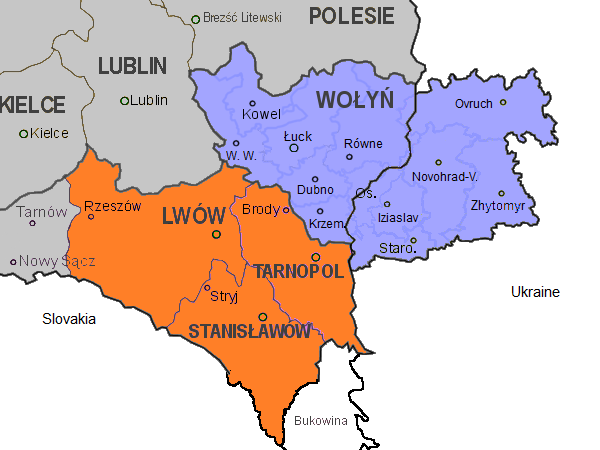|
Northern Ukrainian Dialects
The Northern Ukrainian dialects (), also called the Polesian dialects (), are one of the three main dialect groups of the Ukrainian language, along with Southeastern and Southwestern. Northern Ukrainian is a transitional dialect to the Belarusian language, which is located to the north. A defining characteristic of the Northern dialects is archaic vocalism of stressed vowels, or, in the case of letters "" and "", the usage of monopthongs when stressed. The letter "" also acquires a sound similar to standard Ukrainian "" when not stressed and preceded by a palatised consonant. The northern dialects share a simplified morphology with the Southeastern dialects, which they played a critical role in forming. Some more northwestern dialects, located in Podlachia, however, lack this simplified morphology. In contrast to the Southeastern dialects, which form Ukrainian's literary standard within Ukraine, and the Southwestern dialects, which are the literary standard of the Ukrainian di ... [...More Info...] [...Related Items...] OR: [Wikipedia] [Google] [Baidu] |
Polesia
Polesia, also called Polissia, Polesie, or Polesye, is a natural (geographic) and historical region in Eastern Europe within the East European Plain, including the Belarus–Ukraine border region and part of eastern Poland. This region should not be confused with parts of Russia also traditionally called "Polesie". Extent One of the largest forest areas on the continent, Polesia is located in the southwestern part of the Eastern-European Lowland, the Polesian Lowland. On the western side, Polesia includes the crossing of the Bug River valley in Poland and the Pripyat River valley of Western Ukraine. The westernmost part of the region, located in Poland and around Brest, Belarus, historically also formed part of the historic region of Podlachia, and is also referred to as such. The modern Polish part was not considered part of Polesia by the late 19th-century '' Geographical Dictionary of the Kingdom of Poland'', which defined the region as roughly a triangle between ... [...More Info...] [...Related Items...] OR: [Wikipedia] [Google] [Baidu] |
Belarusian Language
Belarusian (, ) is an East Slavic languages, East Slavic language. It is one of the two Languages of Belarus, official languages in Belarus, the other being Russian language, Russian. It is also spoken in parts of Russia, Lithuania, Latvia, Poland, Ukraine, and the United States by the Belarusian diaspora. Before Belarus Dissolution of the Soviet Union, gained independence in 1991, the language was known in English language, English as ''Byelorussian'' or ''Belorussian'', or alternatively as ''White Russian''. Following independence, it became known as ''Belarusian'', or alternatively as ''Belarusan''. As one of the East Slavic languages, Belarusian shares many grammatical and lexical features with other members of the group. To some extent, Russian, Ukrainian language, Ukrainian, and Belarusian retain a degree of mutual intelligibility. Belarusian descends from a language generally referred to as Ruthenian language, Ruthenian (13th to 18th centuries), which had, in turn, descend ... [...More Info...] [...Related Items...] OR: [Wikipedia] [Google] [Baidu] |
Volhynia
Volhynia or Volynia ( ; see #Names and etymology, below) is a historic region in Central and Eastern Europe, between southeastern Poland, southwestern Belarus, and northwestern Ukraine. The borders of the region are not clearly defined, but in Ukraine it is roughly equivalent to Volyn Oblast, Volyn and Rivne Oblasts; the territory that still carries the name is Volyn Oblast. Volhynia has changed hands numerous times throughout history and been divided among competing powers. For centuries it was part of the Polish-Lithuanian Commonwealth. After the Russian annexation during the Partitions of Poland, all of Volhynia was made part of the Pale of Settlement on the southwestern border of the Russian Empire. Important cities include Rivne, Lutsk, Zviahel, and Volodymyr (city), Volodymyr. Names and etymology *, ; * ; *, ; * or ; *; * ; *; *; * or (both ); Volhynian German: , , or (all ); *, or . The alternative name for the region is Lodomeria after the city of Volodymyr (city ... [...More Info...] [...Related Items...] OR: [Wikipedia] [Google] [Baidu] |
Dialects Of Belarusian Language De
A dialect is a variety of language spoken by a particular group of people. This may include dominant and standardized varieties as well as vernacular, unwritten, or non-standardized varieties, such as those used in developing countries or isolated areas. The non-standard dialects of a language with a writing system will operate at different degrees of distance from the standardized written form. Standard and nonstandard dialects A ''standard dialect'', also known as a "standardized language", is supported by institutions. Such institutional support may include any or all of the following: government recognition or designation; formal presentation in schooling as the "correct" form of a language; informal monitoring of everyday usage; published grammars, dictionaries, and textbooks that set forth a normative spoken and written form; and an extensive formal literature (be it prose, poetry, non-fiction, etc.) that uses it. An example of a standardized language is the French langu ... [...More Info...] [...Related Items...] OR: [Wikipedia] [Google] [Baidu] |



